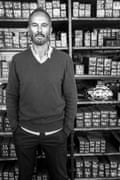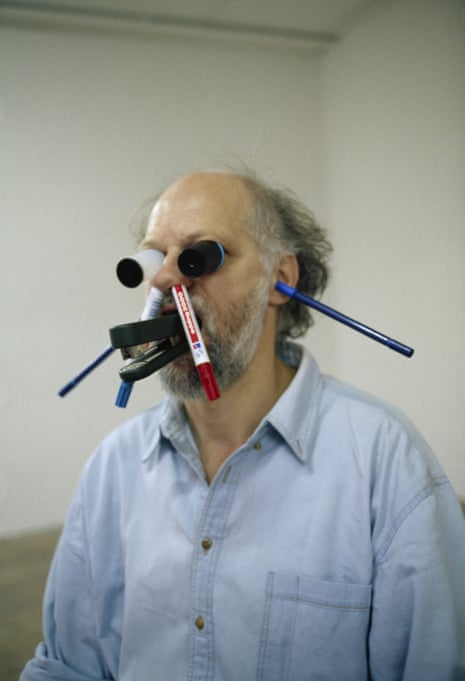This is the director of the Künstlerhaus art gallery in Bremen. I helped him to put the pens in his nose and ears because he couldn’t see much after he had taken off his glasses and put film canisters in his eyes. Using just his face and these everyday items he was transformed into a living sculpture, and I quickly snapped him to document this short-lived artwork.
Taken in 1997, it was one of the first pieces in a series that came to be known as One Minute Sculptures. I had been exploring the relationship between people and everyday objects for a few years, so when the Künstlerhaus invited me to put on a one-man show, I decided to make my work about the people employed there and the materials that surrounded them. I didn’t send any artwork, instead I went to the gallery 10 days early and created the pieces there. I asked the museum director to pick out the objects in his office that he regularly used for work.
I had a really good time making these photographs, but I was always on the edge of how far I could push boundaries, how much I could ask people to do without them saying “enough is enough”. For those taking part, the experience hovered between desperation, laughter and willingness to be part of an artwork.
When you have a camera in your hand and call something art, people are prepared to do some really crazy and stupid things. But this series isn’t about creating jokes, it’s about the line between putting yourself out there and being self-conscious – it’s about psychological situations that we all find ourselves in. It can either make people laugh or cry.
After Bremen, I was invited to exhibit all over the world and decided to open the work up to the public. In France, a bank manager wanted to be photographed withtwo big sticks of asparagus up his nose. I shot him outside his bank with all the staff standing behind me. They were laughing like hell but he thought he was so cool, he felt he was a different guy, and this in turn made him very attractive.
My interest in everyday objects came from when I was a young artist and had no money at all. I was always looking for cheap materials to work with and the cheapest things I found were those closest to me. My studio was near a wood workshop so I made use of wood scraps that were in the garbage. Later, I moved next to a can factory and started using cans. Eventually I took to using my old clothes. In the end everything became a possible material for an art piece and that was very exciting.
This series has had a lot of interest from outside the art world, fashion designers and people in the music industry have used it and that has opened my work up to a whole new audience. If you look online you can find that there are people making their own one-minute sculptures, so it’s found its own way into the public realm and I’m not connected with it any more. I’m really happy with that.

CV
Born: 1954 in Styria, Austria.
Studied: Art in Salzburg and Vienna.
Influences: The Austrian writer Thomas Bernhard, Marcel Proust, Samuel Beckett.
High point: As well as the One Minute Sculptures, the Fat Car series was also incredibly successful.
Low point: When Harald Szeemann didn’t include me in an exhibition of top Austrian artists. Ten years later he put me in a show, so I was very happy then.
Top tip: Hold on, don’t give up and don’t chase money early on, because in the beginning it can be dangerous to earn too much.
- Performing for the Camera is at Tate Modern, London, from 8 February until 12 June.

Comments (…)
Sign in or create your Guardian account to join the discussion